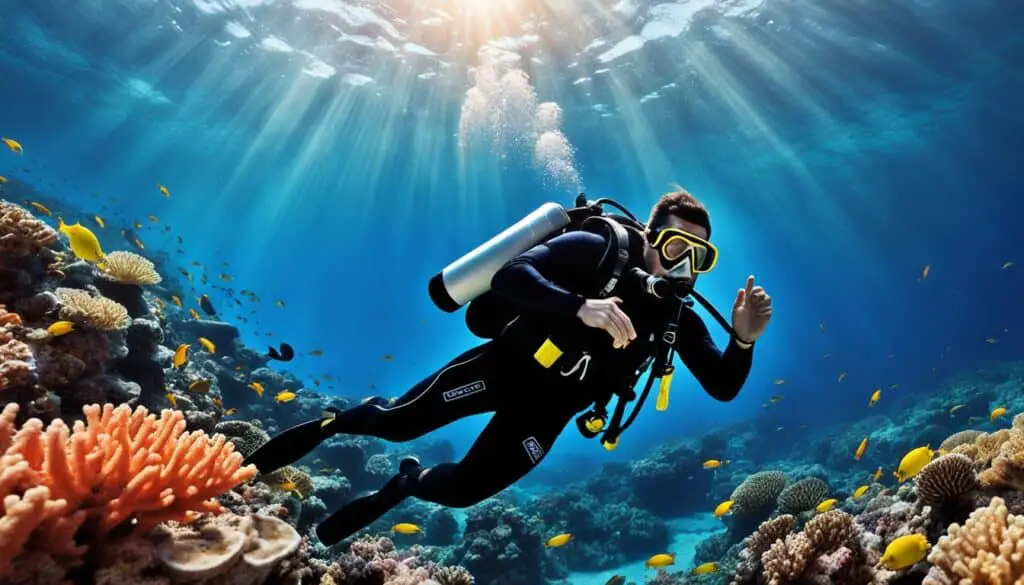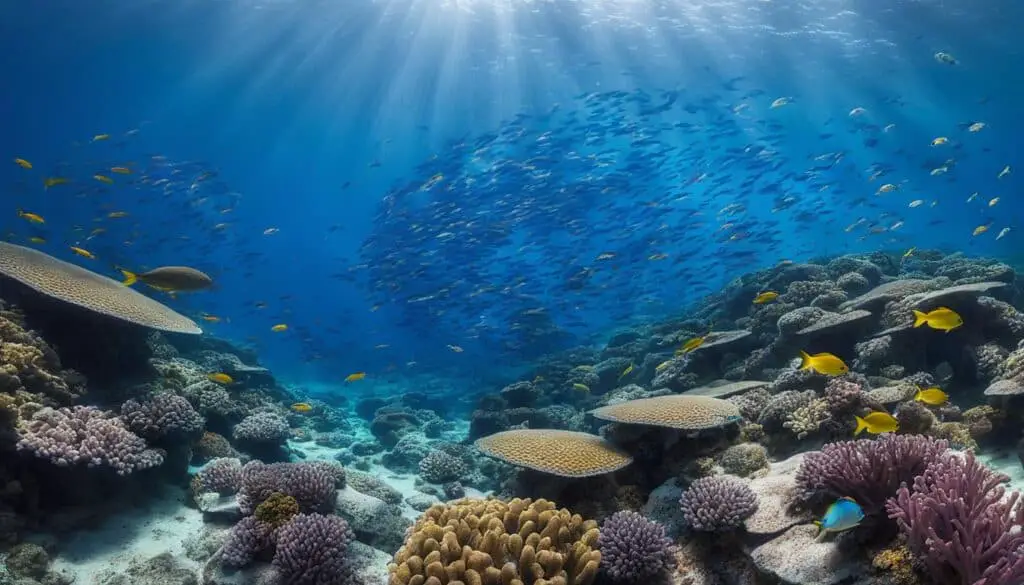When it comes to diving, the Mediterranean offers a treasure trove of underwater wonders. But what are the best times to dive in this captivating region? Dive seasons, underwater clarity, and marine life encounters all play a crucial role in determining the ideal diving conditions.
Whether you’re a seasoned diver or just starting out, understanding the factors that influence the dives can help you plan unforgettable underwater adventures. So, let’s dive deeper into the Mediterranean mysteries and discover the best dive times and locations.
Key Takeaways:
- The Mediterranean offers stunning diving opportunities year-round
- Dive seasons vary depending on the region, with summer being the peak season
- Water temperature can range from 68-78°F (20-25°C) in summer to 50-59°F (10-15°C) in winter
- Visibility is generally good, ranging from 30-100 feet (10-30 meters)
- The Mediterranean is home to diverse marine life, including dolphins, turtles, and octopuses
The Seasons of the Mediterranean
The Mediterranean has distinct dive seasons characterized by different conditions. During the summer months, from June to August, the water is warm and visibility is generally excellent. This is the peak season for diving, with many divers flocking to popular destinations.
In contrast, winter diving, particularly from December to February, offers its own allure. The water may be colder, but there are fewer tourists, and marine life encounters can be incredibly rewarding.
The shoulder seasons of spring (March to May) and autumn (September to November) provide a balance between favorable diving conditions and fewer crowds.
“The sea, once it casts its spell, holds one in its net of wonder forever.” – Jacques Yves Cousteau
Mediterranean Dive Locations
The Mediterranean is a treasure trove of dive locations, offering something for divers of all levels of experience. From the stunning Costa Brava in Spain to the beautiful Greek islands and the picturesque Turkish coast, there are numerous dive sites waiting to be explored. What sets the Mediterranean apart is its incredible marine biodiversity, showcased by vibrant reefs, fascinating caves, and unique underwater rock formations. But that’s not all – the Mediterranean is also home to a rich collection of wrecks, including ancient shipwrecks and relics from World War II.
When it comes to choosing the best dive spots in the Mediterranean, it can be overwhelming given the plethora of options. So, here is a curated list of some of the popular dive sites:
The Blue Hole, Gozo, Malta
Located off the coast of Gozo, the Blue Hole is known for its dramatic underwater archway that leads to a cavernous chimney. This site offers a thrilling dive experience, with unique rock formations and abundant marine life, including octopuses, groupers, and moray eels.
The Zenobia, Larnaca, Cyprus
The Zenobia wreck, located near Larnaca, Cyprus, is considered one of the best wreck dive sites in the world. This massive roll-on/roll-off ferry sank in 1980 and is now home to an array of marine life. Divers can explore the ship’s cargo holds and corridors, encountering barracudas, groupers, and other fascinating species.
The Medes Islands, Costa Brava, Spain
The Medes Islands, a marine reserve located on the Costa Brava in Spain, is a paradise for divers seeking marine biodiversity. The area is teeming with colorful fish, including damselfish and wrasses, as well as larger creatures like groupers and moray eels. With its crystal-clear waters and underwater caves, the Medes Islands offer a truly enchanting diving experience.
These are just a few examples of the incredible dive sites the Mediterranean has to offer. Whether you’re an avid wreck diver or a lover of marine biodiversity, the Mediterranean will surely leave you in awe of its underwater wonders.
Explore the Mediterranean’s underwater world and discover the beauty that lies beneath its azure surface.
Water Temperature and Visibility
The Mediterranean is known for its diverse dive conditions, with varying water temperatures and visibility throughout the year. Understanding these factors is crucial for planning successful and enjoyable dives in this stunning region.
Water Temperature
The Mediterranean experiences a range of water temperatures based on the seasons. During the summer months, from June to August, divers can expect comfortable temperatures averaging 68-78°F (20-25°C) in many areas. This warm water creates ideal conditions for underwater exploration and marine life encounters.
As the winter season sets in, the water temperature drops to around 50-59°F (10-15°C), making it cooler for diving. While the colder temperatures may deter some divers, this season offers unique opportunities for those seeking more solitude and breathtaking winter landscapes beneath the surface.
Visibility
Visibility in the Mediterranean is generally good, ranging from 30-100 feet (10-30 meters). This allows divers to appreciate the stunning underwater scenery and observe marine life with clarity. However, it’s important to note the presence of thermoclines, which are sudden changes in water temperature that can affect visibility in certain areas.
“The varied water temperatures and visibility in the Mediterranean provide divers with diverse experiences throughout the year. From warm summer dives with high visibility to tranquil winter explorations, there is something for every diver in this captivating region.” – Dive Master Michel
To make the most of your Mediterranean diving adventure, it’s important to be prepared for temperature variations and plan your dives accordingly. Wetsuits or drysuits of appropriate thickness depending on the season, along with proper dive planning, will ensure a comfortable and enjoyable experience.
An image of a scuba diver exploring the Mediterranean underwater world:

| Season | Water Temperature (°F/°C) | Visibility (feet/meters) |
|---|---|---|
| Summer (June – August) | 68-78°F (20-25°C) | 50-100 feet (15-30 meters) |
| Winter (December – February) | 50-59°F (10-15°C) | 30-60 feet (10-20 meters) |
Marine Life in the Mediterranean
The Mediterranean is a haven for marine life enthusiasts, offering a plethora of captivating species and breathtaking encounters. Whether you’re a seasoned diver or a first-time explorer, the Mediterranean’s rich biodiversity never fails to impress. From vibrant fish species to majestic dolphins, graceful turtles, and elusive octopuses, there is something for everyone beneath the shimmering surface.
“The sea, once it casts its spell, holds one in its net of wonder forever.” – Jacques Yves Cousteau
When diving in the Mediterranean, you can expect to come across an array of fish species that call the region their home. The Mediterranean damselfish dazzles with its vibrant colors, creating an underwater spectacle. Keep an eye out for groupers, known for their impressive size and striking features, as well as moray eels that lurk in crevices, adding an element of intrigue to your dives.
One of the most thrilling encounters in the Mediterranean is swimming alongside dolphins. These intelligent and playful creatures often approach divers with curiosity, creating unforgettable moments. Turtles are also a common sight, gracefully gliding through the water, their ancient allure captivating all who witness their presence.
And then there are the fascinating octopuses, masters of disguise and cunning intelligence. With their ability to change colors and shape-shift, these cephalopods captivate divers as they navigate their enigmatic marine world.
The Mediterranean’s commitment to marine conservation has led to the establishment of numerous marine protected areas, safeguarding the habitats of these cherished marine species. These efforts ensure the preservation of the Mediterranean’s marine biodiversity, allowing future generations of divers to continue experiencing its wonders.

The Mediterranean’s Diverse Marine Life:
| Fish Species | Dolphins | Turtles | Octopuses |
|---|---|---|---|
| Mediterranean Damselfish | Common Dolphin | Loggerhead Turtle | Common Octopus |
| Grouper | Bottlenose Dolphin | Green Turtle | Golden Octopus |
| Moray Eel | Short-beaked Common Dolphin | Leatherback Turtle | Atlantic Octopus |
Exploring the Mediterranean’s underwater world is an adventure that exceeds expectations, where every dive unveils new wonders. With diverse marine life and protected habitats, the Mediterranean truly offers a mesmerizing experience for all who dive into its depths.
Conclusion
When it comes to diving, the Mediterranean offers something for everyone, regardless of the time of year. Whether you prefer warm waters and high visibility or a more intimate diving experience with unique encounters, this stunning region has it all.
Planning ahead is crucial to make the most of your Mediterranean diving experience. Consider factors such as your skill level, weather conditions, and the specific dive locations you want to explore. Researching the best dive times in the Mediterranean and understanding marine life migrations can help you tailor your dive plan to suit your preferences.
During the summer months, the Mediterranean is a haven for diving enthusiasts, with its warm waters and excellent visibility. However, don’t overlook the shoulder seasons and winter diving opportunities. These off-peak times not only offer fewer crowds, but they also provide a chance to encounter unique marine life and explore the captivating underwater landscapes in a more intimate setting.
So, whether you’re a seasoned diver or new to the sport, the Mediterranean promises an unforgettable diving experience throughout the year. Dive deep into its crystal-clear waters, discover its vibrant marine life, and create memories that will last a lifetime.
FAQ
What are the best dive times in the Mediterranean?
The ideal dive times vary depending on the region. Factors such as water temperature, visibility, and marine life migrations play a role in determining the best seasons for diving.
What are the dive seasons in the Mediterranean?
The Mediterranean has distinct dive seasons characterized by different conditions. These include summer (June to August), winter (December to February), spring (March to May), and autumn (September to November).
Where are the best dive spots in the Mediterranean?
The Mediterranean offers a wide range of dive locations to explore. Some popular spots include Spain’s Costa Brava, the Greek islands, and the coast of Turkey. These areas boast colorful reefs, caves, underwater rock formations, and fascinating wreck dives.
What is the water temperature and visibility like in the Mediterranean?
The water temperature in the Mediterranean can range from a comfortable 68-78°F (20-25°C) in summer to colder temperatures of 50-59°F (10-15°C) in winter. The visibility is generally good, ranging from 30-100 feet (10-30 meters), but thermoclines may affect clarity in certain locations.
What kind of marine life can I encounter in the Mediterranean?
The Mediterranean is teeming with diverse marine life. Divers can expect to encounter various fish species such as Mediterranean damselfish, groupers, and moray eels. Dolphins, turtles, and octopuses are also commonly spotted in certain areas.
How should I plan my Mediterranean diving experience?
Choosing the best time to dive in the Mediterranean depends on personal preferences, desired dive experiences, and specific dive locations. Summer offers warm waters and high visibility, making it popular among diving enthusiasts. However, diving in the shoulder seasons and winter can provide unique encounters and a more intimate diving experience. Planning ahead and considering factors such as skill level, weather conditions, and marine life migrations can help ensure a memorable Mediterranean diving adventure.
